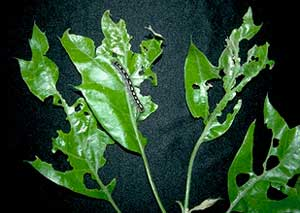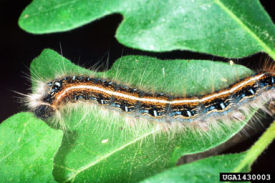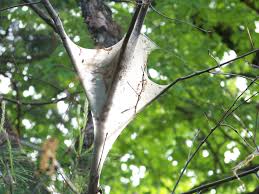Emerging from a spider-web like tent of white silk and often seen on wild black cherry trees and those of apples, pears, plums and peaches, tent caterpillars are a common orchard pest that can defoliate entire trees in a growing season.
Tent caterpillars, as they are commonly known, are members of a family of Lasiocampiadae moths who are hairy and are usually brightly colored with blue and yellow spots.
 Among the most predominant species, the eastern species (Malacosoma americanum) is identified by a white stripe down its back and for building a single large tent in a tree, whereas others species build smaller separate tents throughout.
Among the most predominant species, the eastern species (Malacosoma americanum) is identified by a white stripe down its back and for building a single large tent in a tree, whereas others species build smaller separate tents throughout.
The Life Cycle
Shiny egg masses containing 150-400 eggs appear in the nodes of branches during the winter and hatch in early spring when the leaf buds begin to unfurl. The lively lot soon construct silken tents, which they occupy during the early morning and evening, when they are not feeding on the foliage and leaving silk trails along the tree mapping their route back to nest. The larva become fully grown (2 inches long) six weeks after hatching and pupation occurs soon thereafter on tree trunks, fences or litter. Two weeks later the adult moths hatch and the cycle  begins anew, as adults leave the next batch of eggs to overwinter into the next season.
begins anew, as adults leave the next batch of eggs to overwinter into the next season.
Controlling Tent Caterpillars
Stopping tent caterpillars in their silky tracks is important to protect orchard trees from becoming a caterpillar buffet. Planet Natural recommends the following protocol:
1. Scrape off and discard overwintering egg masses and tear the protective tents out by hand before the larvae start to feed. A spiky stick can be used to remove the tents or they can be pruned out depending on their location.
2. Control caterpillar movement and restrict access to feeding areas with Sticky Tree Bands or Tanglefoot Pest Barrier.
3. Apply Bacillus thuringiensis, var. kurstaki (Bt-k) or Monterey Garden Insect Spray (Spinosad) to the leaves to kill feeding caterpillars.
4. If necessary, spot treat with plant-derived insecticides as a last resort. Spray must penetrate silken tents for effective control.
For more information:
This edition of POP TIPS prepared with assistance from POP intern Alyssa Schimmel.
